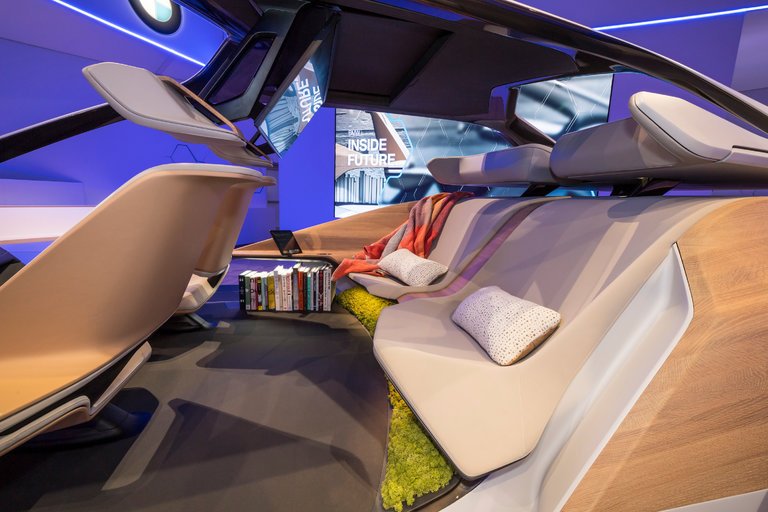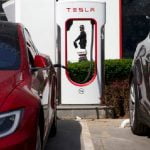
Swiveling seats? Movies projected across the windshield? Social media feeds on the windows? As driverless car technology develops, companies, design institutes and researchers are asking the question: What does the car of the future look like on the inside?
With companies like Google, Uber and others racing ahead to develop fully autonomous vehicles, the era of the driver hunched over the steering wheel may eventually give way to a living room on wheels. But with its long development lead times, designers are already thinking about how such technology will change the interiors of cars.
“When people are in an autonomous vehicle, their expectations will shift,” said Hakan Kostepen, executive director for strategy and innovation at Panasonic’s automotive systems unit, a major industry supplier. “They will want their personal space to become one of smart mobility, connecting them and relevant information to act upon.”
When cars are fully autonomous, how we sit, inform and entertain ourselves will be up for grabs. If steering wheels are no longer needed, how do we best configure seating positions? What should be done with the space now occupied by a dashboard, once a vehicle handles all driving tasks and even decides when it needs to be serviced?
At ArtCenter College of Design in Los Angeles — one of the world’s premier automotive design schools — 14 students recently worked on creating new concepts for a future vehicle interior whose occupants would no longer be shackled by the need to drive.
Participants were picked from multiple disciplines, including product design, transportation and graphics. To fuel their discussions, specialists in the fields of sound composition, olfactory reaction and even animal behavior were brought in. Visual strategists from NASA’s Jet Propulsion Laboratory paid a visit as well.
The proposals, which were reviewed by executives from the carmaker BMW, the electronics firm Nvidia and IBM’s Watson artificial intelligence division, varied wildly.
GRAPHIC
The Race for Self-Driving Cars
There are increasing signs that autonomous cars have arrived — and may be driving on our city streets sooner than we think.

In one concept, social media feeds were displayed on the windows and an all-glass roof, creating what is known as an augmented reality projection, providing contextual information on passing landmarks and approaching sights. As the vehicle drove by a restaurant, reviews of the eatery would be displayed and an online reservation form would appear on the building.
Video games would be integrated into the passing environment. Players could fire “weapons” at buildings, and then, via a projection on the glass, see the structure go up in digital flames.
Another group envisioned a vehicle’s interior as a constantly changing environment, using variable lighting and temperatures to fit the evolving moods and desires of each occupant, as determined through a sensor analysis of physiological and emotional states.
A third proposal contemplated the use of virtual reality and motion-sensing seats to give occupants the feeling of driving a sports car, even when they were simply riding in a tame autonomous vehicle.
The concepts are not wholly pie in the sky — graduates of the ArtCenter have gone on to design vehicles like BMW’s i3 electric car and Tesla’s Model S — but nevertheless are a step beyond what is being developed by vehicle manufacturers and suppliers, who must take cost, brand reputation and consumer acceptance into account.
Panasonic is one such company, and it is considering ideas like altering a vehicle’s internal lighting depending on its occupants’ moods or allowing a child passenger to initiate a search to find a nearby parking spot. Like students at the ArtCenter, Panasonic is also looking at using the windshield as an overlay for additional information or advertisements. The company declined to say how much it was spending on researching vehicle interiors, but said it was a “substantial” amount.
BMW is experimenting with keeping instruments at a low height. When necessary, the “driver” or responsible party would interact with controls through a holographic projection that would appear to hover closer to eye level in space, meaning they would not need to take their eyes off the road while adjusting the temperature or changing radio stations.
To confirm that a command was registered, the driver would receive haptic feedback transmitted in space, but while it would feel as if one were touching a button on an Android smartphone, the user would not physically be touching anything.

When the vehicle is in fully autonomous mode, the windshield could be turned into a wide-screen display, allowing passengers to watch a movie; theater-like seats would vibrate in sync with sound effects.
Speakers embedded in each seat would also include noise-cancellation technology to ensure that only the person watching could hear the soundtrack, music or phone call in progress. When the driver has to take control of the vehicle, rear-seat passengers could be entertained using a large screen lowered from the roof.
In an autonomous vehicle, “we can push technology into the background and only make it present when it’s needed,” said Holger Hampf, BMW’s head for user experience.
One thing the carmaker does not envision: swiveling, rear-facing seats. “When you reverse the seats you can induce motion sickness,” Mr. Hampf said.
Panasonic and BMW are far from the only companies developing the future of automobile interiors.
Valeo, a France-based automotive supplier to General Motors and other companies, has 14,000 engineers working on future vehicle projects, drawing in employees from its visibility, comfort and driving, and thermal systems groups to reimagine interiors. It spent 1.6 billion euros, or $1.75 billion, on such research and development last year alone.
The company wants to use light to alert and affect passengers — a glowing orange light on the right-hand side of the vehicle would point passengers to an oncoming danger, while a blue light would combine with air-conditioning to help make the interior feel cooler.
Using artificial intelligence, a vehicle would learn its passengers’ preferences in terms of language, climate and entertainment and then modify itself accordingly, said Guillaume Devauchelle, Valeo’s vice president for group innovation and scientific development. The car could potentially even understand that a passenger had just been to the gym and adjust the cabin temperature accordingly.
Similarly, Bosch, a major German automotive supplier, believes cars will eventually be shared rather than individually owned, and so the company is working on systems that will allow vehicles to automatically personalize themselves. An eye scan, fingerprint or smartphone connection will signal who is getting into the vehicle, so that it can adjust its climate, seating position, favored radio stations and other attributes automatically.
One major question, however, is already being confronted: While much is doable, should it be done?
“On paper, it seems great that I can read email on my car’s window, but will we actually want it?” Mr. Kostepen of Panasonic said. “A car has to maintain its brand DNA even when it is fully autonomous.”
[“Source-ndtv”]





